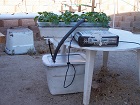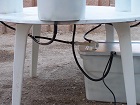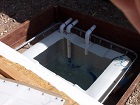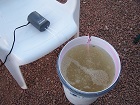What size reservoir do I need
Often times when a grower encounters problems with their hydroponic systems, it's due (at least in part) by a reservoir that's to small for their plants. When the plants are still small, people simply forget that they will get bigger. The bigger they get, the more water, nutrients, and oxygen they will need to consume. The same way the amount of food and drink a full grown adult consumes for a meal is much greater than what a toddler can consume.
So how do you know how big of a reservoir you need? Luckily there's a simple and easy general rule of thumb to use as guideline. Regardless of what type of hydroponic system your growing in, the water/nutrient solution per plant ratio is the same. So first thing you need to know is how many plants you will be growing in it. The second thing you need to know is how big they get when their full grown. Once you know how many plants, and how big they will get, you can apply the general rule of thumb.
General
rule of thumb for “minimum” reservoir size in hydroponics
- Small plants, minimum ½ gallons per plant
- Medium size plants, minimum 1 to 1 ½ gallons per plant
- Large plants, minimum 2 ½ gallons per plant
The general rule of thumb as stated is just the “minimum” water volume per plant recommendations. There are environmental conditions that will greatly affect water and nutrient uptake by the plants. Don't be afraid to go larger, we prefer to double the minimum water volume recommendation as our starting point. You don't need to completely fill your reservoir until the plants get larger. But they tend to grow fast in the right conditions, and will quickly out grow a smaller reservoir before you know it. Changing over to a larger reservoir half way through a grow costs more money, not to mention is also a big hassle.
(Hint) Regardless of the size of your reservoir, make sure to mark the inside with a permanent marker at different levels (1 gallon, 2 gallons, 5 gallons, 10 gallons etc. etc..) that way you always know exactly where the water level is supposed to be, and how much water the plants are using.
Environmental
conditions that affect water and nutrient uptake
Humidity
The humidity level is the biggest factor in how much water the plant drinks up. As the plant transpires (breathes), it exhales water vapor form the leaves. The less water vapor (humidity) that's in the air around the plant, the faster the the plant transpires (breathes out) the water vapor. The more water water vapor the plant transpires, the more water the roots drink up to replace it, otherwise the plant would go limp (like low blood pressure in people).
In high humidity environments like in a greenhouse, the plants wont transpire nearly as much because the air is already saturated with water vapor. Thus the roots won't drink up as much water to replace it either. Most plants do best when the humidity levels are between 60 and 80 percent. If your humidity level is below 40-50 percent, the plants will drink up significantly more water the lower it is, and you should increase the water volume per plant to help compensate.
Heat
Naturally as you would expect, temperature is a major factor in a plants water uptake. Some plant types tolerate heat better than others. But all plants need more water as the temperatures go up regardless. Even in high humidity, the plants will need to drink up more water when the temperatures rise than they would in normal temperatures. Also, when the temperatures rise and the plants transpire to cool down, their taking up more water than nutrients. So a less concentrated nutrient solution is better. Something like ½ to ¾ strength normal depending on how hot. But you'll still want a larger than the minimum water volume per plant to compensate for the extra water the plant will be drinking.
It's not just air temperature that cause heat stress for the plant, nutrient solution and root zone temperatures are very important as well. The plants roots have evolved growing underground where their insulated from above ground temperatures. Underground the roots are protected where the temperature is consistently cool and moist regardless of changes above ground. When the root zone temperature rises above this comfortable range, stress begins and the plant begins to go into survival mode. Flower and fruit drop begins, the plants starts to droop and wilt. If the high root zone temps continue to rise, it will eventually kill/cook the roots and cause the plant to die.
Duration of light, and light intensity
While not a major factor, the light intensity and duration of light the plants get also affect both the plants water and nutrient uptake. They affect it through photosynthesis. The plant needs light to be able to photosynthesize, and it uses both water and nutrients while it's doing so. The light intensity greatly affects how well and fast the plant can conduct photosynthesis. The plant drinks up most of the water it uses during photosynthesis. The more daylight hours the plant gets, the longer it's able to conduct photosynthesis, and thus use both water and nutrients.
Wind
While humidity plays a factor here as well, wind (even a breeze) will increase the plants transpiration rate. This will happen even with high humidity levels, but is much more drastic in with low humidity. If you have high humidity, you want a constant light breeze on your plants foliage. That will help reduce the likelihood of disease from fungal spores germinating on the wet leaves.
Problems
you can encounter when the reservoir is not big enough.
There are a number of problems you may encounter if your reservoir is to small as your plants get bigger and consume more water and nutrients.
Nutrient solution fluctuations
When growing plants hydroponically it's important to give the plants a balanced nutrient solution. As well as a constant level of consecration of those nutrients as much as possible. Plants are adaptable and will adjust the best they can to their environment, but large swings in their environment causes stress on the plants. Stress free plants grow faster and healthier.
Just about any commercially made hydroponic nutrient designed for hydroponics will provide a balanced nutrient. But the concentration of that nutrient depends on the amount of water it's mixed with. The manufacture of the hydroponic nutrient can give you directions on mixing it for a full strength nutrient solution, as well as mixing it for the stage of growth your
 plants
are in. But keeping the right concentration requires keeping the same
amount of water volume all the time, even as the plants are drinking it
up.
plants
are in. But keeping the right concentration requires keeping the same
amount of water volume all the time, even as the plants are drinking it
up. It's important to remember that the plants only take nutrients out of the water as they need them, and leave what they don't need. They don't take water and nutrients in even proportions.
 So
as the plants drink up more water, and leave the excess nutrients it
didn’t need at the time. It's reducing the water volume and
concentrating the nutrients along the way, the nutrient level become
more and more concentrated the lower the water volume gets. Not only
does this cause stress for the plants, but it can also cause some
mineral elements/salts (nutrient molecules) to bond together if it
becomes to concentrated. When they bond together, they become unusable
to the plants regardless of water volume, and/or if-and-when the
correct water volume (nutrient concentration) is back to normal in the
reservoir. The molecules wont separate when more water is added, and
the roots can't absorb minerals that have bonded.
So
as the plants drink up more water, and leave the excess nutrients it
didn’t need at the time. It's reducing the water volume and
concentrating the nutrients along the way, the nutrient level become
more and more concentrated the lower the water volume gets. Not only
does this cause stress for the plants, but it can also cause some
mineral elements/salts (nutrient molecules) to bond together if it
becomes to concentrated. When they bond together, they become unusable
to the plants regardless of water volume, and/or if-and-when the
correct water volume (nutrient concentration) is back to normal in the
reservoir. The molecules wont separate when more water is added, and
the roots can't absorb minerals that have bonded. The best way to reduce nutrient fluctuations is to use a larger reservoir. The plants will still drink up the same amount of water and nutrients, but as the amount of water volume (nutrient solution) goes up, the percentage of the total water volume the plants need out of it goes down. Reducing the fluctuations, as well as the need for daily replacement of water to the reservoir.
As the plants drink up water, you will need to replace it between nutrient solution changes. You just want to replace it with fresh plain water. That will restore the total water volume, and keep the concentration of nutrients from building up. If you want to stretch out time between nutrient solution changes, you can add some diluted nutrient solution once in a while.
(Hint) Regardless of the size of your reservoir, make sure to mark the inside with a permanent marker at different levels (1 gallon, 2 gallons, 5 gallons, 10 gallons etc. etc..) that why you always know exactly where the water level is supposed to be, and how much water the plants are using.
Big pH swings
pH swings can be caused by large fluctuations in nutrient solution water levels for a couple reasons as well. As mentioned big fluctuations in nutrient concentrations can cause mineral salts (nutrient molecules) to bond. This can cause pH to changes. Also every time you add more water to replace the used water, that will change the pH, unless you replace it with water that has already been pH balanced. The more water you need to add back, the more your adding to the problem.
Most nutrients that are designed for use hydroponic systems contain pH buffers. But they wear down. You may not notice it much right after you changed your nutrient solution, but as the buffers try harder and harder to keep the pH in range through the fluctuations, the quicker they wear down. Then you'll notice the pH swings getting bigger as time goes by.
Oxygen depletion
Water is H2O, the “O” is for oxygen. While you cant breathe it (unless you have gills like a fish), water contains oxygen molecules and is referred to as “Dissolved Oxygen.” Like fish gills, the plants roots can absorb the dissolved oxygen directly from the water also. As the plants get bigger they need more oxygen. If it's not replaced quick enough, the plants can deplete the dissolved oxygen from the water quickly as they get big. The smaller the water volume, the less dissolved oxygen the plants have to use. You can read more about it on our Dissolved Oxygen (DO) page.










